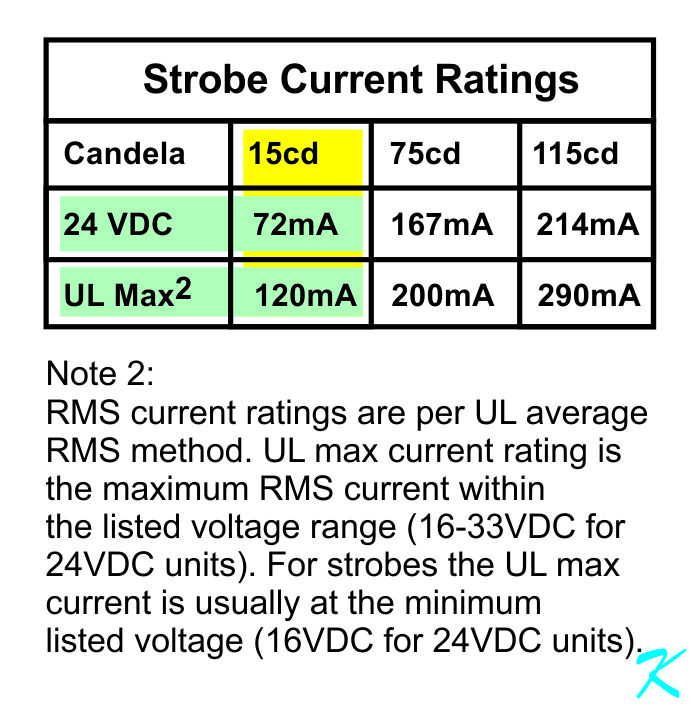Life Safety
To properly understand the answers, we have to look at a fire alarm system as a life safety system. In other words, a fire alarm system has to work all the time, not just when it's convenient.
All fire alarm systems have two sources of power. They use utility power, but when there's a power outage, the fire alarm system switches to using a second source of power, usually a battery.
Nominal Voltage
A 24-volt battery voltage is not 24 volts; the 24-volts, shown in the name of the battery is just that, only the name. Because a battery uses chemicals to create voltage, the true voltage varies according to its state of charge.
A 24-volt nominal battery, for instance, is actually slightly higher than 27 volts when it is fully charged. As the battery is used, it's voltage slowly lowers. When the battery is almost used up, its voltage is close to 20 volts. Further use of the battery causes the voltage to quickly drop toward zero volts.
The voltage of a battery, when it's discharged, is arbitrarily chosen by the fire alarm panel's manufacturer, but the voltage is usually somewhere between 20.2 volts and 22 volts.
Even at the end of a 24-hour power blackout from the utility company, the size of the backup battery is calculated to keep the fire alarm system operating, and also in case of fire, usable for warning the occupants of the building.
Notification Appliance Circuit Voltage
Most fire alarm systems use a nominal voltage for the Notification Appliance Circuit (NAC) screw terminals on the panel. Almost always, this nominal voltage is tied directly to the nominal voltage of the battery. The battery has been calculated to keep the fire alarm system working for 24 hours, so it can be assumed that after 24 hours, the NAC power supply voltage is 20.2 volts to 22 volts.
The bast choice, when making voltage drop calculations on the NAC circuit, is to use the manufacturer's calculation worksheet in the installation manual. This is the easy way to check and see if the NAC circuit is going to actually work.
When the Calculation worksheet isn't available, if you can, get the panel's minimum voltage out of the installation manual for the system, or call the technical support team for the fire alarm system's manufacturer.
This is the voltage to use for calculations at the screw terminals of the panel.
As a last resort, use a rule-of-thumb voltage. The rule-of-thumb panel voltage is 20 volts for a 24-volt system, and 10 volts for a 12-volt system. In essence, whenever you use a rule-of-thumb, make sure that any errors will be on the side of life safety.
Again, this is the voltage to use for calculations at the screw terminals of the panel.
Unless the fire alarm system installation manual specifies that the power supply is a
REGULATED 24 volts, always assume the listed 24-volt power supply voltage is really in a range of 20 volts to 27.5 volts.
Strobe and Horn Currents
All strobes are constant power devices. No matter what voltage is getting to the strobe, all strobes flash at the same regular rate, and are the same regular brightness. In the case you're asking about, the voltage can be anywhere between 16 volts and 33 volts.
That means, to keep the power (wattage) constant, the strobes have to use more current when the voltage goes down, and less current when the voltage goes up. That's not Ohm's Law; that's Watt's Law -
Watts equals Voltage times Current. It's W (in Watts) = E (Electromotive Force in Volts) x I (Intensity of Current in Amps).
Some fire horns, particularly low frequency horns, are also constant power devices. Read the data sheets carefully to see what is happening.
Strobe Current Ratings
The fire alarm system is a life safety system. Because it's a life safety system, all voltages and currents used in the NAC voltage drop calculations should be considered as if a blackout has lasted 24 hours.
Here, the strobe current at 15cd for 24 VDC is 72ma. In order for the manufacturer to show an exact current (72ma), the voltage has to be REGULATED and not a nominal 20 to 27.5 volts. That REGULATED voltage doesn't happen in most fire alarm systems; that's not a voltage that can be used for real-world calculations.
For the same strobe, the current at 15cd for UL Max2 is 120ma. According to Note 2, at the bottom of the data sheet, "2 RMS current ratings are per UL average RMS method. UL max current rating is the maximum RMS current within the listed voltage range (16-33VDC for 24VDC units). For strobes the UL max current is usually at the minimum listed voltage (16VDC for 24VDC units)."
UL, or Underwriters Laboratories, is showing the highest level of current that the strobe uses. This current is what the strobe is using when the voltage at its input screw terminals is 16 VDC.
Life Safety is Real-World Safety
The 72ma current doesn't happen in the real-world; the 120ma current is the current that should be used.
This is a life safety calculation. Rule of thumb - anytime there's more than one current listed for a particular setting on a strobe or horn, use the higher current value in the voltage drop calculations.
Douglas Krantz


